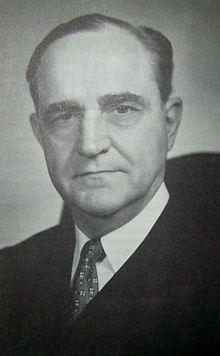Sherman Minton
| Sherman Minton | |
|---|---|
 |
|
| Associate Justice of the Supreme Court of the United States | |
|
In office October 12, 1949 – October 15, 1956 |
|
| Nominated by | Harry Truman |
| Preceded by | Wiley Rutledge |
| Succeeded by | William Brennan |
| Judge of the United States Court of Appeals for the Seventh Circuit | |
|
In office May 12, 1941 – October 12, 1949 |
|
| Nominated by | Franklin Roosevelt |
| Preceded by | Walter Treanor |
| Succeeded by | Walter Lindley |
| Senate Majority Whip | |
|
In office July 22, 1937 – January 3, 1941 |
|
| Leader | Alben Barkley |
| Preceded by | Hamilton Lewis |
| Succeeded by | Lister Hill |
|
United States Senator from Indiana |
|
|
In office January 3, 1935 – January 3, 1941 |
|
| Preceded by | Arthur Robinson |
| Succeeded by | Raymond Willis |
| Personal details | |
| Born |
October 20, 1890 Georgetown, Floyd County, Indiana, U.S. |
| Died | April 9, 1965 (aged 74) New Albany, Indiana, U.S. |
| Political party | Democratic |
| Spouse(s) | Gertrude Gurtz |
| Education |
Indiana University, Bloomington (BA, LLB) Yale University (LLM) |
| Military service | |
| Allegiance |
|
| Service/branch |
|
| Rank |
|
| Battles/wars |
World War I • Battle of Verdun • Battle of Soissons |
Sherman "Shay" Minton (October 20, 1890 – April 9, 1965) was a Democratic United States Senator from Indiana and an Associate Justice of the Supreme Court of the United States.
After attending college and law school, he served as a captain in World War I, following which he launched a legal and political career. In 1930, after multiple failed election attempts, and serving as a regional leader in the American Legion, he became a utility commissioner under the administration of Indiana Governor Paul V. McNutt. Four years later, Minton was elected to the United States Senate. During the campaign, he defended New Deal legislation in a series of addresses in which he suggested it was not necessary to uphold the Constitution during the Great Depression crisis. Minton's campaign was denounced by his political opponents, and he received more widespread criticism for an address that became known as the "You Cannot Eat the Constitution" speech. As part of the New Deal Coalition, the fiercely partisan Minton championed President Franklin D. Roosevelt's unsuccessful court packing plans in the Senate and became one of his top Senate allies.
After Minton failed in his 1940 Senate re-election bid, Roosevelt appointed him as a judge to the United States Court of Appeals for the Seventh Circuit. After Roosevelt's death, President Harry Truman, who had developed a close friendship with Minton during their time together in the Senate, nominated him to the Supreme Court. He was confirmed by the Senate on 4 October 1949, by a vote of 48 to 16, 15 Republicans and one Democrat (Harry Flood Byrd of Virginia) voting against him. He served on the Supreme Court for seven years. An advocate of judicial restraint, Minton was a regular supporter of the majority opinions during his early years on the Court; he became a regular dissenter after President Dwight Eisenhower's appointees altered the Bench's composition. In 1956, poor health forced Minton's retirement, after which he traveled and lectured until his death in 1965.
...
Wikipedia
